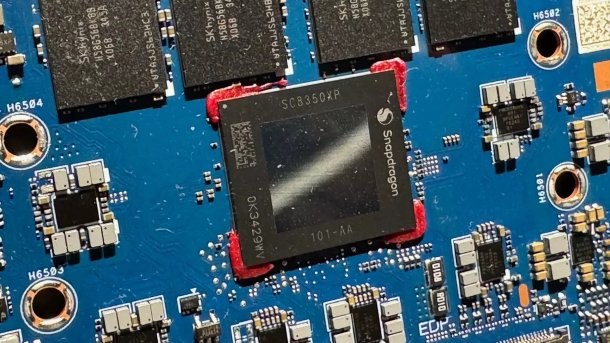ARM wants to revoke Qualcomm's architecture license
The mud-slinging between ARM and Qualcomm continues to escalate. Qualcomm is no longer allowed to sell Snapdragon processors with Nuvia technology.

Qualcomm's Snapdragon X processor shown here is a thorn in ARM's side because the company wants more license fees.
(Image: c't / mue)
The feud between architecture designer ARM and processor designer Qualcomm has reached a new level. There have been differences of opinion since 2021, which culminated in a legal dispute in 2022 because ARM wants more money from Qualcomm – one of ARM's most important licensees. Its Snapdragon processors are found in the second most Android smartphones; only the cheaper Mediatek chips are even more widespread.
Qualcomm confirmed to the news agency Bloomberg that ARM intends to withdraw its own architecture license from the company with a lead time of just 60 days. Qualcomm would then no longer be allowed to develop its own CPU cores with the ARM instruction set.
Nuvia technology still under fire
This concerns the so-called Oryon cores, which Qualcomm acquired with the takeover of the start-up Nuvia. They were first used in the Snapdragon X Elite and Snapdragon X Plus notebook processors for Windows-on-ARM devices sold since June.
The first smartphone processor with Nuvia technology is called Snapdragon 8 Elite – the first models with it are due to be released this year.
ARM's argument: companies are not allowed to take over architecture licenses from other companies. As a start-up, Nuvia presumably had more favorable conditions than Qualcomm would have received. Qualcomm, on the other hand, argues that its own license would cover the Nuvia cores anyway.
ARM is publicly demanding that Qualcomm destroys all processors with Nuvia technology in order to build up pressure. However, ARM is actually concerned with renegotiating the license fees. ARM already disclosed at the end of 2021 that it was looking for growth markets to increase its own sales. One such market is Windows notebooks with ARM processors. It also became clear from the legal dispute with Qualcomm that ARM wants to earn more money per ARM processor produced (so-called royalties).
Nobody gives in
Both companies are not giving an inch and are heading for court hearings. Qualcomm in particular seems to be riding the razor's edge with the expansion of its Oryon portfolio. The legal dispute could also be a reason why Qualcomm has not yet updated the Oryon cores to ARMv9 with the Scalable Matrix Extension (SME) AI extension. This has led to a proliferation: the previous Snapdragon 8 Gen 3 was still compatible with ARMv9, while the new Snapdragon 8 Elite is taking a step back to ARMv8.
Videos by heise
No immediate effects are to be expected. Qualcomm is likely to insist on its own view and continue to sell processors with Nuvia technology until the matter is decided in court. Analysts expect that Qualcomm and ARM will ultimately meet in the middle and that license costs will rise.
Empfohlener redaktioneller Inhalt
Mit Ihrer Zustimmung wird hier ein externer Preisvergleich (heise Preisvergleich) geladen.
Ich bin damit einverstanden, dass mir externe Inhalte angezeigt werden. Damit können personenbezogene Daten an Drittplattformen (heise Preisvergleich) übermittelt werden. Mehr dazu in unserer Datenschutzerklärung.
(mma)